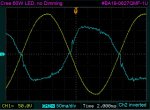140324-0830 EDT
Little Bill:
Any delay to turn on phase shift dimmer for any purpose should be a 3-wire type. What I mean by 3-wire is:
1. It is not a 2-wire dimmer.
2. It requires a neutral connection.
3. It may have more than three wires.
When you have a 3-wire dimmer the electronics are powered from the full input line voltage under all conditions of the load. Under no-load the dimmer still works. Under any dimmer setting position when input power is applied the dimmer provides output current, and equivalent to when it was depowered.
Several 40 to 60 W equivalent LEDs I have measured have a PF of about 0.97 at no dimming. Close to a sine wave current load with no phase shift dimming. The ones I tested also dim very well with a Variac. Actually better because a lower equivalent voltage can be applied. These comments do not apply to any CFLs that I have tested.
With the Cree bulbs I have measured I don't think there would need to be a 150 W limit, but if you need to stay within published rating limits, then 150 is your limit. Note: an LED requires about 1/5 the power of an equivalent incandescent. 150 * 5 = 750. 150 W of 10 W LEDs is 15 bulbs.
These comments do not directly answer your question, but provide background.
You might ask the dimmer manufacturer if the 150 W limitation really applies to 0.97 PF LEDs.
.



